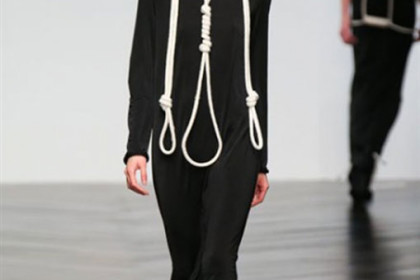
Contaminations. Away from disaster movies and environmental disasters, contamination seems a creative imperative now. Unknown scopes and environments combine to give birth to something new, unexpected and exciting. It’s like entering the realm of endless possibility, where everyone has the right to exist. Cinema, photography, visual arts, music… and fashion.
Textile creations are no strangers to the world of art, not only for inspiration but in essence: what are they but the result of artists giving shape to their works on fabrics and materials rather than on film or linen? And this year’s woman fashion is contaminated by materials and shapes that, in theory, are not congruous, like the strings of Central Saint Martins: loops and knots wrap clothes, bodies and faces. Ropes create movement or stop it, stick fragment of fabric to the body and let other fragments loose, revealing glimpses of skin, human matter’s windows. It is the humanization of style, like fan dresses from the same collection: away from the light pleats, fabric becomes an architectural dimension and stands tall on shoulders, waist and legs instead of following curves down.
You touch a building, you look at it, you live in it, at most, and today, you put it on. And the solid form always leaves room for a fragment of life, of humanity, if you contaminate someone or something, the living component cannot remain extraneous to the shape created.
Just look around: buildings, shopping centers, industrial buildings that raise up through the air and occupy the landscape, crossing any suburbs, you can see skeletons of disused or half finished buildings: as clothing hanging in a closet. Art, in its every form, draws inspiration from what surrounds it, and thus fashion dresses up in solid volumes, and the creations of the Central Saint Martins are not unique, even the clothes of the fashion designer Mary Katrantzou emerge from the silhouette: they do not follow the body, nor hide it, as a building with its tenants: the hills towering up like skyscrapers and the line of the shoulders comes up, tense, like a windowsill.
We are an industrial society and what we wear reflects it, some would argue that we are also a technological and mediatic society, and, certainly, the feedback will soon reveal itself, you just have to figure out how to transfer microchip, web and passwords into garments but, sure, someone will face the challenge.
 English
English  Italiano
Italiano 



